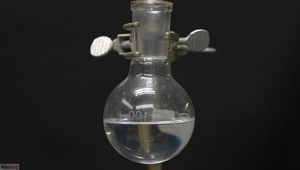Difference between revisions of "Benzaldehyde"
| Line 126: | Line 126: | ||
==Preparation== | ==Preparation== | ||
| − | Perhaps the most straightforward preparation of benzaldehyde is through the oxidation of benzyl alcohol in an aqueous solution containing an oxidizer. | + | Perhaps the most straightforward preparation of benzaldehyde is through the oxidation of [[benzyl alcohol]] in an aqueous solution containing an oxidizer. Benzyl alcohol is slightly soluble in water, although benzaldehyde's solubility in water is much lower. So with good stirring, proper stoichiometry, and plenty of time, it should be easy to produce using anything from household bleach to potassium permanganate. As a bonus, potassium permanganate is reduced to MnO2, which can also oxidize benzyl alcohol, so it's important to take this into account when calculating stoichiometry. |
Another common route to benzaldehyde is the oxidation of [[toluene]] with [[chromyl chloride]], process known as Étard reaction.<ref>https://www.youtube.com/watch?v=rYKoj247rhg</ref> | Another common route to benzaldehyde is the oxidation of [[toluene]] with [[chromyl chloride]], process known as Étard reaction.<ref>https://www.youtube.com/watch?v=rYKoj247rhg</ref> | ||
| Line 148: | Line 148: | ||
===Storage=== | ===Storage=== | ||
| − | Since benzaldehyde is sensitive to air and light, it should be stored in amber bottles, which are then made air-tight by sealing them with sealing tape, like [[parafilm]]. Schlenk flasks can also be used. | + | Since benzaldehyde is sensitive to air and light, it should be stored in amber bottles, which are then made air-tight by sealing them with sealing tape, like [[parafilm]]. Schlenk flasks can also be used to store this compound. |
===Disposal=== | ===Disposal=== | ||
Revision as of 15:41, 20 May 2018
 Benzaldehyde distilled from bitter almond oil, with traces of water.
| |
| Names | |
|---|---|
| IUPAC name
Benzaldehyde
| |
| Systematic IUPAC name
Benzenecarbaldehyde | |
| Other names
Benzenecarbonal
Benzenecarboxaldehyde Benzoic aldehyde Phenylmethanal | |
| Properties | |
| C7H6O C6H5CHO | |
| Molar mass | 106.12 g/mol |
| Appearance | Colorless liquid |
| Odor | Almond-like |
| Density | 1.050 g/cm3 (15 °C) 1.044 g/cm3 (20 °C) |
| Melting point | −57.12 °C (−70.82 °F; 216.03 K) |
| Boiling point | 178.1 °C (352.6 °F; 451.2 K) |
| 0.3 g/100 ml (20 °C) 0.695 g/100 ml (25 °C) | |
| Solubility | Miscible with diethyl ether, ethanol, methanol Soluble in anh. ammonia |
| Vapor pressure | 1.27 mmHg (25 °C) |
| Thermochemistry | |
| Std enthalpy of
formation (ΔfH |
−36.8 kJ/mol |
| Hazards | |
| Safety data sheet | Sigma-Aldrich |
| Flash point | 64 °C |
| Lethal dose or concentration (LD, LC): | |
| LD50 (Median dose)
|
1,300 mg/kg (rat, oral) |
| Related compounds | |
| Related compounds
|
Benzoic acid |
| Except where otherwise noted, data are given for materials in their standard state (at 25 °C [77 °F], 100 kPa). | |
| Infobox references | |
Benzaldehyde is an organic chemical compound, the simplest aromatic aldehyde. It has the formula C6H5CHO.
Contents
Properties
Chemical
Benzaldehyde will slowly oxidize in air, forming mainly benzoic acid.
- C6H5CHO + ½ O2 → C6H5COOH
Physical
Benzaldehyde is a colorless liquid, which has a characteristic almond-like odor. It is immiscible with water, but miscible with organic solvents, such as alcohols and ethers.
Availability
Benzaldehyde is difficult to acquire in many countries, due to its use in the manufacturing of illegal drugs. In US it is considered a List I chemical, meaning it cannot be legally purchased without a permit.
A good source of benzaldehyde is bitter almond oil, which is mostly crude benzaldehyde. It can be purified via vacuum distillation or steam distillation in an inert atmosphere.[1] However, keep in mind that since the bitter almond oil is basically crude benzaldehyde, legally there's no distinction between the oil and impure benzaldehyde. In US it's illegal to import bitter almond oil without proper paperwork.
Preparation
Perhaps the most straightforward preparation of benzaldehyde is through the oxidation of benzyl alcohol in an aqueous solution containing an oxidizer. Benzyl alcohol is slightly soluble in water, although benzaldehyde's solubility in water is much lower. So with good stirring, proper stoichiometry, and plenty of time, it should be easy to produce using anything from household bleach to potassium permanganate. As a bonus, potassium permanganate is reduced to MnO2, which can also oxidize benzyl alcohol, so it's important to take this into account when calculating stoichiometry.
Another common route to benzaldehyde is the oxidation of toluene with chromyl chloride, process known as Étard reaction.[2]
Another more accessible route involves the retro-aldol reaction of cinnaldehyde with sodium carbonate. The yield of this reaction is pretty low, but cinnamon oil is more readily available than bitter almond oil. The reaction takes place in distilled water.
Oxidation of benzyl alcohol with sodium persulfate will give benzaldehyde.
Carbonylation of benzene is another route, but may not give a good yield and uses toxic carbon monoxide.
Projects
- Flavoring agent
- Make mandelic acid
- Make bee repellent
Handling
Safety
Benzaldehyde has low toxicity, though it may be irritant. The lethal dose for a 70 kg adult is considered to be 50 ml. Benzaldehyde does not accumulate in any tissues, and is metabolized and then excreted in urine.
Some studies indicate that benzaldehyde might have anti-cancer properties.
Storage
Since benzaldehyde is sensitive to air and light, it should be stored in amber bottles, which are then made air-tight by sealing them with sealing tape, like parafilm. Schlenk flasks can also be used to store this compound.
Disposal
Benzaldehyde should be mixed with a more volatile solvent and safely burned outside. Another more lengthy route involves oxidation to benzoic acid, which is less volatile and can be safely dumped in trash.